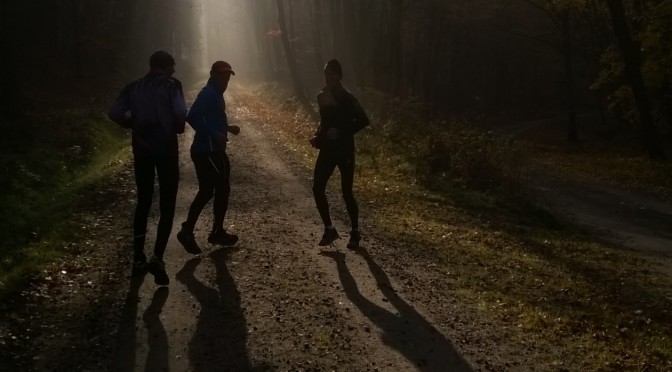Miało być o poświęceniu, trudach treningu, bólu, a tu podróż do przeszłości. Będzie i o tym, ale pozwólcie na chwilę rozgrzewki, dodatkowo chcemy, by nowi czytelnicy dołączyli. W grudniu zaplanowane jest 150km czystego biegu, do tego basen i ćwiczenia na sali – a jak wyjdzie zobaczymy. Biegniemy ostatnio wspólny trening i chłoniemy polodowcowy krajobraz, koledzy wysłuchali historii jak hartował się teren no i sypnęły się pytania: skąd przyszli „malarze” do Cro- Magnon? Co sprawiło, że ludzie opuścili Afrykę? Przed nami był długi podbieg, tempo uczciwe, ciężko biec a co dopiero mówić więc najchętniej odpowiedziałbym jednym słowem – „zlodowacenia”, ale … jest kilka smaczków wartych drobnego wysiłku.
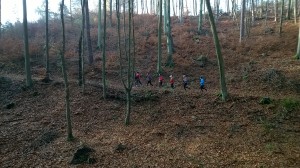
Przypomnij sobie z lekcji geografii – płyty kontynentalne były kiedyś połączone, potem rozpadły się i od tego czasu dryfują, Ameryka nadal oddala się od Europy – jesteś ze mną czytelniku? Oczywiście – to pamiętasz, choć już od następnych wersów zacznie ubywać pewności. Antarktyda jest lądem, ale Arktyka nie! Arktyka to płyty lodowe, albo inaczej lądolód, otoczony północnymi morzami i dalej krawędziami Rosji, Kanady, Grenlandii Norwegii. Tam nie ma stałego lądu, a kiedyś było tylko morze – wodna dziura. OK. – choć w Sopocie czekałeś na kolegów z Cro–Magnon, słuchasz raczej opowieści Indo – Europejczyków, którzy znali kolegów z jaskini z Dordonii i to dość dobrze. Ten racjonalny, starszy w skórze renifera wykorzystuje moment i powraca do plam na słońcu i cykli Milankovicia, – ale! – podkreśla mocniejszym głosem – sama zmiana kąta padania słońca i jego mniejsza intensywność była niewystarczająca, potrzebne było wzmocnienie. Otóż sam mróz, nawet bardzo silny nie zamrozi morza, które miesza się z ciepłymi wodami, a jeśli już, to jak u licha lodowiec ma wejść na ląd? Potrzebne są zimne lata, by lód nie stopniał i ogromne ilości opadów by zasypywać ląd. Cykl zmiany kąta nachylenia osi ziemi załatwił nam krótkie i zimne lato na półkuli północnej. Jest czas ok. 3 mln lat temu i procesy wulkaniczne wypiętrzają Przesmyk Panamski łącząc obie Ameryki, który wcześniej całą swoją szerokością 2tys km przepuszczał prąd morski równikowy, który mieszał wody dzisiejszego Atlantyku z Pacyfikiem.
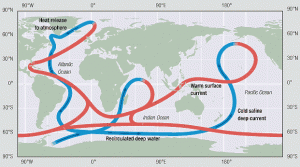
Jak pojawiła się nowa bariera to prąd morski odbił się od powstałej zatoki i zaczął płynąć z powrotem (Zatokowy – Golfstrom), północnym Atlantykiem ogrzewając Zachodnią Europę, Wyspiarzy i pchając się na północ, ale do czasu. Tam będąc słony i ciężki zapadał się pod słodkie, lodowate warstwy wód Oceanu Arktycznego. Wówczas to znikał z powierzchni, ale jednocześnie przyspieszał robotę nad … tworzeniem człowieka. Zderzenie, niesionych przez Prąd Zatokowy, gorących i wilgotnych mas powietrza z lodowatymi zaczęło produkować ogromne ilości opadów, w tym śniegu, który zaczął zasypywać północną półkulę. Biały kolor stał się tak modny, że coraz rzadziej był zmieniany przez matkę ziemię, co powodowało, że promienie słoneczne odbijały się nie dogrzewając i nie roztapiając postępującego lodu – zaczęła się ostatnia z 5 wielkich epok lodowcowych. To przez Panamę! krzyknął czerwony na twarzy zaciskając pięści. – Nie przez, ale dzięki Panamie – uspakajał gość w reniferach. Nastąpiło lekkie poruszenie, niektórzy wyciągnęli pamiętniki i szukali wpisów na pierwszych stronach – zrobił się lekki szum, pojawiły się wątpliwości. Nasz ród zszedł z drzewa 5 mln lat temu – chwali się gość w lisach, – moi wcześniej o jakiś 1 mln lat – dopowiada dumny gość przy szatni. Toś jest od orangutanów, ale gdy wróciły na drzewo to cię zapomniały – parska śmiechem wysoki, barczysty blondyn przy barze. Czujesz, że potomek neandertalski o niebieskich oczach musiał studiować i wie, że orangutany mają kilka zachowań typowo ludzkich i próbowały przed nami postawy wyprostowanej, ale się nie powiodło i powróciły na bezpieczne drzewa. Mieszaniec neandertalski już koncyliacyjnie, widząc, że jest przyczyną tumultu, szepcze coś swojej dziewczynie do ucha i po chwili wszyscy słyszą piękną muzykę, chwila artystycznej przerwy studzi emocje a na końcu okazuje się, że flet to pamiątka po neandertalskiej babci sprzed 50 tysięcy lat.
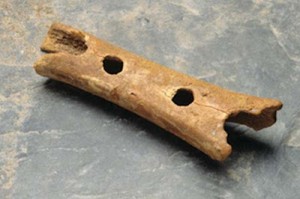
Jest całkiem miło. – To my się musimy jeszcze cofnąć w czasie – wbija się umiejętnie powracający intelektualista, zapada cisza. Zmiany klimatyczne na północy, zmiany zasięgu lodowca skutkowały zmianami klimatu w centralnej Afryce. Tam od ponad 6 mln lat, w trzech różnych środowiskach trwały nieśmiałe próby wypadu naczelnych na otwartą przestrzeń. Po okresie 3 mln lat, kiedy pojawiły się zmiany klimatyczne podstawowe siedliska – lasy tropikalne i kusząca bogactwem sawanna raz były większe raz mniejsze, natomiast lasy parkowe, które stanowiły salę treningową przed wyprawą, wariowały w rytmie pojawiasz się i znikasz.
Niskie, rzadkie drzewka dawały odpowiednie podparcie i schronienie, jednocześnie zmuszały do przejścia coraz większego dystansu bez podpórki. Czasami, w okresach suchych, brakowało w ogóle tego parku i trzeba było sporej odwagi, może ciekawości, by wyjść na otwarta przestrzeń sawanny. Te zakłócenia i zmiany zaskakiwały i wykuwały nowe przystosowania związane raczej z wszechstronnością niż specjalizacją – były początkiem wypadu na plener malarski do Cro-Magnon. Uff ćwiczenia trwały dość długo [ok. 2 mln lat ] – bo jak pamiętasz za pędzle artyści chwycili 40-50tys lat temu. Starszy jegomość zakończył i spojrzał na dno prawie pustej szklanki. Opowieść o Panamie i zmianie klimatu w Afryce spowodowanej lodowcem w Europie, był spójny, logiczny, ale był jeden problem – data. 2,6 mln lat temu, dopiero wtedy ludzie?! Kłamca! Proszę tu są dowody, zdjęcia moich najbliższych – i to nie był jedyny głos na sali. Towarzystwo zaczęło wyciągać albumy fotograficzne i z emocją w głosie udowadniać – o proszę u pradziadka (4,4mln lat ) jest pionowe zakończenie kości udowej – świadczy to o wyprostowanej postawie czy nie?
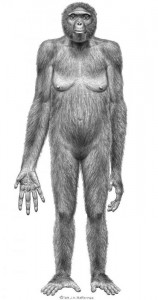
Ktoś inny – u naszej babuni jest pięta i palec chwytny u stopy już praktycznie niewidoczny a na zdjęciu jest dokładna data – 3,8 mln lat. Stłamszony gość od orangutana, triumfalnie wyciągnął zdjęcie i prowokacyjnym tonem zapytał blondyna – jest kulisty otwór w czaszce umieszczony centralnie od spodu? Jest, czy nie ma? Sala ucichła, blondyn, górując nad żądnym rewanżu Indo, odpowiedział – pionowe osadzenie głowy to nie jest wystarczający dowód. Dokładnie tak jak u małp, które mają pozycję pionową i nie chodzą, ale … wiszą na długich rękach. Musisz mieć kompletne udo i stopę z piętą … orangutanie – a masz u mnie drinka i przeprosiny, jeśli pokażesz ścięgno …. Nie dokończył, przybysz o niewielkim wzroście szybkim ruchem wyciągnął kościany nóż i wbił z całej siły w masywną klatkę piersiową, być może jednego z ostatnich, bliższych potomków Neandertali. Sala zamarła, pozbawienie życia nie było czymś wyjątkowym, to raczej niedokończona informacja o ścięgnie, które pozwala nam czuć się w pełni człowiekiem, bardziej nurtowała przybyszów.
Już powoli zaczynamy chodzić, a wkrótce pobiegniemy – spokojnie 🙂 Kolejny wpis ukaże się w czwartek 25 grudnia a wcześniej jeszcze 22.12 życzenia świąteczne. Tomek
- Thanks to glaciers we are walking upright
Translation – Anna Meysztowicz
This was supposed to be about sacrifice, the difficulties of training and pain, but here we are travelling back in time. It will be about this but let us do a quick warm up first, additionally we would like for new readers to join us. For December we have planned 150 km of clean running, as well as the pool and indoor training – we will see how this works out. Recently we were running together and taking in the post-glacier scenery, my friends were listening to the story of how the area became tempered and the questions came flying: where did the “painters” in Cro-Magnon originate from? Why did the people leave Africa? We had a long run ahead of us at a fair tempo, it’s difficult enough to just run without speaking so I would have happily answered with just one word – “Ice Ages” but… there are a few tasty morsels that I had to share.
Try and remember your geography lessons – the continental plates were once conjoined, then they separated and have been adrift from that time on. America keeps on distancing itself from Europe – are you with me, reader? Of course you remember this but, as for the next lines, your certainty will fade. Antarctica is land, but the Arctic is not! The Arctic is just ice plates, in other words a continental glacier, surrounded by the northern seas and the further borders of Russia, Canada, Greenland and Norway. There is no stable land here and once it was only seawater – a water hole. Ok, even though you were waiting for your friends from Cro–Magnon in Sopot, you are listening more to the stories of the Indo-Europeans, who knew the friends from the cave in Dordogne and quite well at that. The sensible older one in the reindeer skin seizes the moment and returns to the story of patches on the sun and the Milankovitch cycles: But! he stresses in a strong voice – the very change in the angle of the sunlight and its lower intensiveness was insufficient, it needed to be stronger. Freezing temperatures themselves, even if very strong, will not freeze the sea, which mixes with warm waters and, if it does, how in the world is a glacier supposed to form on land? You need cold summers so that the ice doesn’t melt and large amounts of snowfall to cover the land. The cycle of change of the angle of the Earth’s axis has arranged for a short and cold summer on the northern hemisphere. It is approx. 3 million years ago and volcanic processes are outcropping the Panama Canal joining the two Americas, which earlier, with its entire width of 2,000 km, let through the equatorial sea current that mixed the waters of today’s Atlantic Ocean with the Pacific.
When the new barrier appeared, the sea current bounced off the newly-formed bay and began flowing back (the Gulf Stream), via the northern Atlantic Ocean, heating up Western Europe, the Islands, and pushing to the north, but not for long. There, being heavy and salty, it collapsed under the sweet and freezing layers of the Arctic Ocean. At that time it disappeared from the surface but simultaneously sped up the process of… creating human life. The collision of the hot and humid air masses brought in by the Gulf Stream, with the icy ones, began to produce great amounts of precipitation, including snowfall, which began to cover the northern hemisphere. White became so popular that the mother Earth stopped changing colour so often, which meant that the sunrays reflected off it without heating and melting the progressing ice – the last of the five great ice ages had begun. That was Panama’s fault! Shouted the red-faced guy, closing his fists. Not fault but thanks to Panama, soothed the dude in the reindeer skin. A slight commotion broke out, some pulled out their diaries and searched for entries on the first pages – it grew noisy, doubts were voiced. Our kin climbed down from the trees 5 million years ago, boasted the dude in the fox fur. Mine about 1 million years earlier, added a proud guy by the cloakroom. So you are from the orangutangs, but when they returned to the trees, they forgot to take you! A tall, broad-shouldered blond by the bar bursts into peals of laughter. You feel that the Neanderthal descendent with blue eyes must have a higher education and knows that orangutangs have some typically human behaviour and had tried walking upright before us but hadn’t succeeded and they’d returned to the safety of the trees. The Neanderthal, now conciliatorily, seeing that he is the reason for the uproar, whispers something into his girlfriend’s ear and, after a moment, we all hear beautiful music. The artistic break calms the emotions and it turns out that the flute is a souvenir from a Neanderthal grandmother who lived 50 thousand years before.
It’s quite pleasant. So we need to go further back in time, the intellectual once again pushes in cleverly. Everyone falls silent. Climatic changes in the north, changes in the size of the glacier, resulted in climate changes in Central Africa. There, for over 6 million years, in three different environments, shy attempts were ongoing by primates to move out into open space. After a period of 3 million years, when fundamental climatic changes had affected the habitats – tropical forests and the wealthily tempting savannah were at times bigger and at times smaller, and park forests, which constituted a training room before an expedition, were going crazy to the rhythm of now you see me, now you don’t.
Lower, sparse trees provided the appropriate support and shelter, simultaneously they forced crossing longer and longer distances without support. Sometimes, during periods of drought, this park disappeared completely and it was necessary to gather significant courage, perhaps curiosity, to enter the open savannah. These hurdles and changes astounded and paved the way for new adaptations related more to versatility than any specialisation – they were the initiation into the painting expedition to the Cro-Magnon. Phew, our training lasted quite a long time (around 2 million years) because, if you remember, artists didn’t reach for paint brushes until around 40-50,000 years ago. The older gentleman finishes and looks at the bottom of his nearly empty glass. The story about Panama and climate change in Africa was coherent and logical but there was one problem – the date. Humans only 2.6 million years ago?! Liar! Please, here is the evidence – photos of my close family – and this is not the only voice you can hear. Everyone begins to pull out photo albums and present their evidence, with emotion in their voices – Here you are, a visit at great-grandfather’s (4.4 million years ago), there is a vertical ending of the thigh bone – this is proof of the upright posture, right?
voice you can hear. Everyone begins to pull out photo albums and present their evidence, with emotion in their voices – Here you are, a visit at great-grandfather’s (4.4 million years ago), there is a vertical ending of the thigh bone – this is proof of the upright posture, right?
Someone else: Our granny has a heel and an already barely visible prehensile toe and the photo has the exact date – 3.8 million years. Suffocated, the guy from the orangutang pulls out a photo triumphantly and asks the blond provocatively: Is there a round opening in the skull directly in the bottom middle? Is there or isn’t there? The room falls silent, the blond, towering over the revengeful Indo, says: The upright positioning of the head is not evidence enough. Just like with the monkeys, who remain upright and don’t walk but hang on their long arms. You need to have a whole thigh and a foot with a heel…orangutang – but I’ll apologise and buy you a drink if you show me a tendon… He does not finish, the newcomer of short stature pulls a bone knife out quickly and stabs it with all his strength into the massive ribcage of perhaps one of the last closer descendants of the Neanderthals. The room falls silent. Ending someone’s life isn’t anything exceptional, it is rather the information about the tendon, which enables us to feel fully human, that proves more bothersome to the crowd.
Now we are slowly starting to walk and soon we will run – don’t worry J The next entry will show up on Thursday 25 December and earlier, on the 22nd, Christmas greetings.
Tomek
